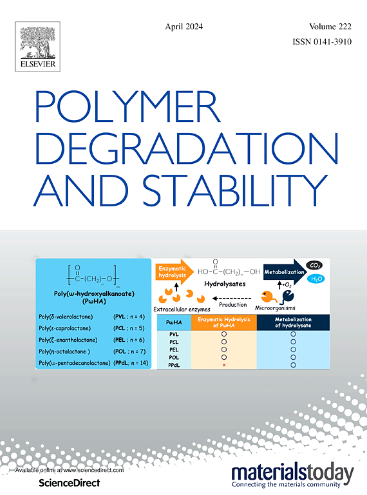含磷/硼的阻燃聚氨酯弹性体,具有出色的机械、形状记忆和回收性能
IF 6.3
2区 化学
Q1 POLYMER SCIENCE
引用次数: 0
摘要
基于可持续发展战略和实际应用要求,开发高强度、可回收和阻燃的聚氨酯(PU)弹性体至关重要。因此,我们精心设计并制备了一种具有动态硼酸酯键和含磷基团的阻燃、可再加工的高性能聚氨酯弹性体(PU-DP 1-7)。傅立叶变换红外光谱(FTIR)和 X 射线光电子能谱(XPS)证实了 PU-DP 1-7 的化学结构。在波长为 900 纳米时,PU-DP 1-7 的透射率约为 60%,磷和硼元素在其表面均匀分布,证实形成了均匀的交联网络。含磷和硼基团的加入使 PU-DP 1-7 具有垂直燃烧(UL-94)V-0 等级,表明其具有理想的阻燃性。此外,PU-DP 1-7 的拉伸强度为 42.7 兆帕,断裂伸长率为 616.9%,由于其网络中含有大量氢键,因此对各种基材具有很高的粘附强度。此外,动态硼酸酯键赋予聚氨酯-DP 1-7 优异的物理回收和形状记忆性能。经过 130 °C 热压后,重整后的 PU-DP 1-7 薄膜在断裂伸长率方面显示出 83.6 % 的回收效率。这项研究提出了一种综合策略,通过引入含磷片段和动态硼酸酯键,制造出具有良好机械和形状记忆性能的阻燃、可回收聚氨酯弹性体。本文章由计算机程序翻译,如有差异,请以英文原文为准。
Phosphorus/boron-containing, flame-retardant polyurethane elastomers with great mechanical, shape-memory, and recycling performances
Based on sustainable development strategy and practical application requirement, it is crucial to develop high-strength, recyclable, and flame-retardant polyurethane (PU) elastomers. Hence, a flame-retardant, reprocessable, high-performance polyurethane elastomer (PU-DP 1–7) with dynamic boronic ester bonds and phosphorus-containing groups was well-designed and prepared. The chemical structure of PU-DP 1–7 was confirmed by Fourier transform infrared spectrometry (FTIR) and X-ray photoelectron spectroscopy (XPS). PU-DP 1–7 shows a transmittance of about 60 % at the wavelength of 900 nm, and phosphorus and boron elements are evenly distributed within its surface, confirming the formation of uniform cross-linking network. The inclusion of phosphorus-and boron-containing groups endows PU-DP 1–7 with a vertical combustion (UL-94) V-0 rating, indicative of desired flame retardancy. In addition, PU-DP 1–7 exhibits a tensile strength of 42.7 MPa and an elongation at break of 616.9 %, with high adhesion strengths towards various substrates due to abundant hydrogen bonds within its network. Furthermore, the dynamic borate ester bonds endow PU-DP 1–7 with superior physical recycling and shape-memory properties. After hot-pressing at 130 °C, the reformed PU-DP 1–7 film shows an 83.6 % recovery efficiency in terms of elongation at break. This work presents an integrated strategy to create flame-retardant, recyclable polyurethane elastomers with great mechanical and shape-memory performances by introducing phosphorus-containing segments and dynamic boronic ester bonds.
求助全文
通过发布文献求助,成功后即可免费获取论文全文。
去求助
来源期刊

Polymer Degradation and Stability
化学-高分子科学
CiteScore
10.10
自引率
10.20%
发文量
325
审稿时长
23 days
期刊介绍:
Polymer Degradation and Stability deals with the degradation reactions and their control which are a major preoccupation of practitioners of the many and diverse aspects of modern polymer technology.
Deteriorative reactions occur during processing, when polymers are subjected to heat, oxygen and mechanical stress, and during the useful life of the materials when oxygen and sunlight are the most important degradative agencies. In more specialised applications, degradation may be induced by high energy radiation, ozone, atmospheric pollutants, mechanical stress, biological action, hydrolysis and many other influences. The mechanisms of these reactions and stabilisation processes must be understood if the technology and application of polymers are to continue to advance. The reporting of investigations of this kind is therefore a major function of this journal.
However there are also new developments in polymer technology in which degradation processes find positive applications. For example, photodegradable plastics are now available, the recycling of polymeric products will become increasingly important, degradation and combustion studies are involved in the definition of the fire hazards which are associated with polymeric materials and the microelectronics industry is vitally dependent upon polymer degradation in the manufacture of its circuitry. Polymer properties may also be improved by processes like curing and grafting, the chemistry of which can be closely related to that which causes physical deterioration in other circumstances.
 求助内容:
求助内容: 应助结果提醒方式:
应助结果提醒方式:


